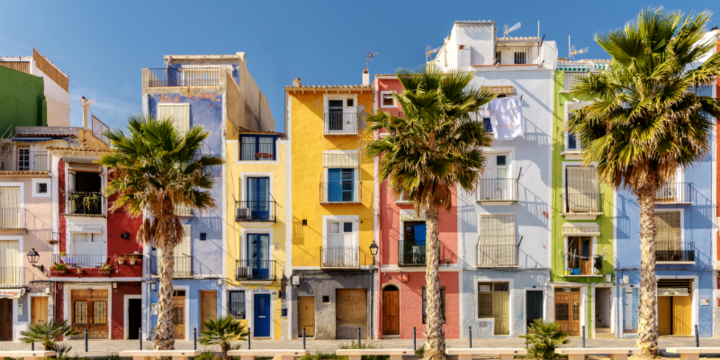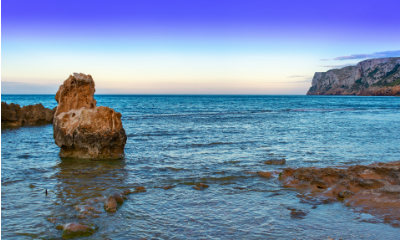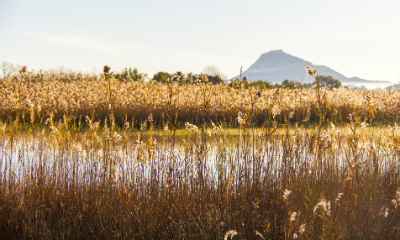Why visit?
- Costa Blanca is great for families, with lots of family-friendly beaches, resorts and activities.
- It’s an affordable spot to go on holiday – it’s good value, easily accessible and well-connected.
One of the most popular of the Spanish Costas, Costa Blanca has over 200km of coastline along the Mediterranean, benefiting from golden sand, plenty of beachside amenities and family-friendly resorts. This region caters widely to tourists, so you’ll find everything you need from this sun-soaked destination. It may be well-known for its beaches and nightlife, but you can still find some quaint fishing villages and old towns if you want to soak up the authentic side of Costa Blanca. Our selection of family-friendly villas are within easy access of beaches, restaurants and villages, so you can experience the best this region has to offer.
Discover the Oliver’s Travels way, where style and character define every handpicked villa in the Costa Blanca. Our destination experts curate unique homes in beautiful locations that are perfect for families and guaranteed to ‘wow’.
Once you book a holiday, the service doesn't stop there. Our Concierge Service means you'll be in good hands to arrange in-house chefs, fridge stocking, housekeeping, and so much more, to make your stay truly extraordinary.
Laced with pearlescent beaches, the Costa Blanca ribbons from the pastel-painted fishing town of Dénia to Pilar de la Horadada in the south. While dazzling sand is the first thing that springs to mind for this 124-mile stretch of Mediterranean coastline, there’s more to the White Coast than the name suggests.
As you travel north from Alicante, the landscape becomes greener and more mountainous. Beyond the towering high rises, you’ll discover a string of quaint Spanish villages, from the precipitous medieval streets of Guadalest to the flower-draped houses of Benissa.
Festivals bring the region alive in a spectacle of music and performance, with classic favourites including the carnival of Hogueras de San Juan and the historic Moors and Christians Fiesta. Live like a local with a Costa Blanca villa rental, many of which come with private pools.

Villajoyosa
Fresh fish and seafood naturally dominate menus along the coast; standouts include grilled tuna from Dénia and baby squid from Moraira. Rice dishes are a Spanish staple, from arroz negro cooked in squid ink to arroz a banda, a paella-style dish made with fish. In the mountainous regions, rich stews are cooked in earthenware pots. A popular sweet treat is turón, the local honey and nut nougat.
Alicante is an underrated wine region, which is in fact designated as a Spanish Denominación de Origen. Don’t miss Moscatel Alicante, a pale white wine made from Muscat grapes.
Sun, sea and sand – it might be a cliché, but Costa Blanca delivers the quintessential Spanish getaway.
Costa Blanca flaunts 300 dry, sunny days a year so there’s rarely a bad time to visit. If you’re there to hike or cycle, October to May are cooler with temperatures rarely exceeding 25°C.
The mercury hovers around 30°C from June to September, with July and August the hottest months – perfect for beach days but perhaps too hot for sightseeing. Temperatures remain mild even through December, making it a popular winter getaway, though January and February can be chilly with rain showers.
Costa Blanca is one of the most family-friendly destinations in Europe. Not only is this corner of Spain just a short flight from the UK, but it also has year-round warm weather and a sea that’s as warm as a bath. Throw in a clutch of adventure parks, and you can keep even the most nonchalant of teens entertained.
The beaches are perfect for kids, with fine sands lapped by crystalline shallows that kids can splash about in. The Mediterranean is a watery playground for older children too, from languid boat trips tracing the contours of the coastline to adrenaline-boosting water-sports above and below the waves.
Many of the towns offer the best of both worlds for families: a slice of authentic Spanish culture for parents to appreciate, alongside plenty of child-friendly attractions. Laid-back Dénia is a great base with its excellent beaches and child-friendly restaurants, while Benidorm is a good day trip for its exhilarating theme parks and water-sports. Elsewhere, Calpe is an adventure hotspot for intrepid types, with everything from quad biking to buggy beach safaris and horse riding.
Costa Blanca villa rentals are ideal for family trips, offering groups more space and a home-from-home environment. One of the major advantages is not having to eat out at restaurants all the time; many villas have terraces with barbecues for alfresco eats. Pick a pad with a pool for cool relief from the midday Mediterranean sun.

Spain is home to an incredible 669 Blue Flag beaches – higher than any other country. The Costa Blanca coastline is threaded with some of the finest, from long powdery swathes to tiny hidden coves. And with 300 days of sun a year, you won’t be left shivering in your swimmers either.
The north of the Costa Blanca couldn’t be more different to the south; quieter and wilder stretches give way to manicured strands teeming with sun-seekers.
Though the main resorts can get crowded, much of the coastline is undeveloped. The limpid waters and safe sands are perfect for young children, while an abundance of water-sports will appeal to older teens too.
Sailing is the most popular water-based activity on the Costa Blanca, with windsurfing and kite surfing in favour when the wind’s up, or sea kayaking and stand-up paddleboarding on calmer days. Divers should head to the marine reserves of Tabarca and the Cape of San Antonio, located between Dénia and Jávea, both of which brim with Mediterranean flora and fauna.
If toes-in-the-sand days top your wish list, be sure to pick a Costa Blanca villa rental near the beach to prevent traffic affecting your stay.
Les Rotes, near Dénia, is a series of five bays set against the backdrop of Montgó nature reserve. There is one sandy beach, Marineta Cassiana, followed by a string of rocky coves with crystalline water. Large boulders throw out shade for dozing babies and create natural rock pools.

Sunset at Les Rotes beach
One of the most family-friendly beaches in Benidorm, Blue Flag-winner Levante is a long curve of creamy sand lapped by clear, calm waters. It has a play park right on the sand and even a beach library (biblioplaya).
Well developed and catering for tourists, this is an excellent beach for facilities, water-sports, and bars where you can grab a cool beer in between sunbathing sessions. Plenty of character makes it a real favourite with families.
Near Moraira, El Portet is a horseshoe-shaped bay sheltered by sloping hills. Balmy shallows are perfect for kids, while calm waves add a little fun for older children. Restaurants and bars line the sandy shore for easy refreshments.
Just up the coast from Jávea, this fine-shingle cove is backed by pine forest. At the foot of rocky cliffs, the quiet beach looks out to the Balearic Islands. Pack snorkelling gear to explore the seabed, and stroll to the clifftop castle.
A great family beach and one that is particularly popular at Christmas, with a real party atmosphere, lots to do, and some pretty awesome beach BBQs. A charming little fishing village and a sweep of clean, golden sand.
Quieter than its southern siblings, Playa Els Molins curves around the small city of Dénia, in the north of Costa Blanca. It’s rather wild and unspoiled, best known for its thriving marine life and protected seabed’s.
While its glorious beaches are Costa Blanca’s main calling card, look beyond the coastline to discover a rich culture and natural beauty. You can immerse yourself in local traditions at lively fiestas and dine on sea-to-plate cuisine at unassuming waterside restaurants. National parks protect cragged mountains pitted with ravines and secluded coves accessible only by water.
Wide valleys conceal quaint hamlets and meandering rivers, which can be explored on foot or by car. Hiking isn’t the only way to explore the landscape; discover remote caves by kayak or cycle climbs worthy of La Vuelta a España – one of the toughest cycling races in the world.
For something a little out of the ordinary, wander the walled town draped across the tiny Isla da Tabarca, or take a day trip to Valencia for its arts and culture scene.
Dénia celebrates more fiestas than any other town in Spain, from the electrifying carnival of Hogueras de San Juan in June to the historic Moors and Christians Fiesta come August. The highlight for many, however, is Santissima a Sangre in July, which involves a Toros a la Mar bull running around the seafront as young men dart out of its path.
Near Jávea, the river-threaded Orba Valley is dotted with tiny hamlets tucked into the folds of foothills. While away a day exploring the ‘Rectoría’, a string of five picturesque villages – Tormos, Rafol, Benidoleig, Sagra and Pedreguer. The mountains are great for hiking: try Sierras del Recingle and the neighbouring Caval and Migdía sierras.
Take a day trip to Valencia to discover its art and culture scene, and excellent restaurants and bars. A hotbed for innovation, the city diverted the flow of its flood-prone river and converted the riverbed into a huge, meandering green space, peppered with futuristic architecture.

Torrevieja hosted the official start of the 74th edition of La Vuelta a España, one of the toughest cycling races in the world, against a backdrop of pink lagoons. Test your mettle on Xorret de Catí, a calf-shredding climb north of Alicante, or start from Calpe beach and scale the Sierra de Bernia and Cumbre del Sol.
One of the last things you would expect to encounter on a holiday to the Costa Blanca is a gushing tropical oasis. Yet just north of Altea, a short drive from the hubbub of the coastal beaches, the River Algar pours through an orchard-filled valley and thunders down the cliffs in a spectacular series of waterfalls. A 1.5-kilometre trail guides you around the nature park where you can discover natural springs, wild herbs and refreshing pools that just beg to be swum in.
The sprawling archaeological complex just outside of modern day Elche is one of the most important in all of Spain. It's famed as the discovery site of the stone bust known as ‘The Lady of Elche’, a well-known piece of Iberian art. It has a prehistory that dates back centuries and spans the Stone Age all the way through to Iberians, Romans, Visigoths and Byzantines.
The Costa Blanca is rather proud of its world-class golf courses, and rightly so. Keen golfers have long carted their clubs to this neck of the woods to enjoy the sunny weather and impeccable facilities. Las Colinas Golf and Country Club weaves through the nearby valleys and has been created with environmental protection at its fore.
Visit Isla da Tabarca, a tiny islet cast adrift from mainland Alicante, to wander its walled town and picturesque port. Explore the cove-bitten coastline before feasting on bowls of caldero overlooking the sea.

Stroll through the palms at UNESCO World Heritage site, Palmeral of Elche. This tranquil park on the outskirts of the town of Elche is a calm labyrinth of pathways through thousands of varieties of palms and plant-life.
The snorkelling and diving in Costa Blanca is exceptional, thanks to its protected marine nature reserve. Nisos Diving take tours out daily for experienced divers and novices alike.
Though many hike Montgó Natural Park, fewer make it to Cova Tallada, accessed by a final 30ft scramble down a sheer cliff face. If this is too fearsome, you can access the cave by kayak or by the cliff-top trail from Dénia – worth the effort for its incredible sea life.

Montgó Natural Park
There’s more to Costa Blanca than high-rise beach resorts. Beyond the buzzy cities of Benidorm and Alicante lies a string of unassuming beauties. Medieval villages cling to sheer cliffs, while inland, terraced hillsides and fruit orchards wrap around authentic Spanish towns.
To the north, you’ll discover a series of traditional fishing villages where wooden boats bob in the sea and buildings are painted in muted pastels. From the arrow-slot streets of Jávea to the precipitous castle-crowned village of Guadalest, there’s a hint of drama in this pocket of Spain.
Natural beauty also nudges up against modern settlements, such as the striking limestone molar looming above Calpe and the glorious collision of mountain and sea in Moraira. And then there are the unexpected surprises: the dizzying castle poised atop a rocky precipice in Guadalest; the trove of art riches in Benissa’s cathedral; the flamboyance of flamingo feeding in the salt lagoon of Calpe.
Wherever you go, one thing you’ll find all towns have in common: warm, welcoming residents who are proud of their culture. What’s more, Costa Blanca villas are dotted throughout both the main towns and the lesser-trodden villages so you can experience local life.
Inland from Benidorm, Guadalest is a vertiginous medieval village perched on top of a steep precipice. A castle is the tiny town’s crowning glory, beneath which the cliff face plunges 1,000ft to a jewel-toned lake below. Orange groves and pine forest surround the town, against a dramatic mountainous backdrop.

Guadalest
Separated from Benidorm by the natural border of Sierra Helada, Altea is the quieter alter-ego to the lively party capital. A pretty fishing harbour and cluster of pebblestone beaches are part of the charm, though it’s the whitewashed old town that steals the limelight, huddled on a hilltop overlooking the gleaming sea.
A candy-coloured huddle of buildings nudges up against a small hill crowned by a tumbledown castle. Originally a traditional fishing town, Dénia has emerged as something of a gastronomic destination, with a cluster of top restaurants. Sandy Blue Flag beaches unfurl to the northwest, while rocky coves cut into the coastline of Les Rotes to the south – excellent diving sites.
Neighbouring Jávea, or Xàbia, is another quaint portside town, draped across a sloping hill. Narrow streets, brimming with tosca sandstone houses, wrap around a Gothic fortress church. The whitewashed buildings of the old town hook around a brilliant blue bay, where terrace cafés offer a front-row seat to fishermen hauling in their catch and sailing boats gliding through the water.
The medieval town of Benissa has a web of cobblestoned streets lined with flower-draped houses, opening onto tranquil squares. The highlight is an art-filled cathedral, which offers a shady haven in the intense midday sun. Expect little pavement cafes serving fresh sardines and stuffed tomatoes from the region, along with wines from local vines.
Moraira hugs the northeastern tip of the Costa Blanca, where forested mountains plunge to turquoise bays. Originally a fishing village, the town is peppered with waterside seafood restaurants, where the menu changes depending on what the local fishermen have caught that day. A pair of Blue Flag-awarded beaches are edged by powdery sands and clear shallows – perfect for kids.
The Gibraltar of Costa Blanca, the dramatic limestone formation of Peñon de Ifach rears out of the sea like a giant’s tooth, looming above the town of Calpe. From here, you can see two crescent bays kissing in the middle, along with the salt lagoon, often filled with pink flamingo. With long powdery beaches, it’s a great family resort.
Your holiday starts the moment you land in Faro. Everything is relatively close by in the Algarve, so getting to and from your villa is quick and easy. If you’re planning self-catering holidays in the Algarve, then our top tip is to hire a car and stop off at the local village market to pick up some fresh produce along the way.
The gateway to the Costa Blanca is Alicante airport, with regular flights from several UK airports, including London Gatwick, Manchester, Newcastle and Bristol. If you’re travelling around Spain, Alicante is easily reached from the rest of the country by high-speed Renfe trains.
From Alicante, Tram Alicante (el Trenet) runs a light-rail train service connecting all major towns along the coast to Dénia, with a changeover in Benidorm. The coastal line takes around 2.5 hours to reach Dénia, and in most parts is a scenic way to travel. Note that the tram doesn’t call at Moraira and Jávea, so if you’re heading to these towns the nearest tram station is in neighbouring Teulada. From here you’ll have to continue by taxi or hire car.
You can also travel the Costa Blanca by bus, though this is slower and more convoluted in parts. ALSA connects all major coastal towns between Valencia and Alicante, including Dénia, Calpe, Altea and Benidorm.
It is also possible to fly into Valencia airport, which may be useful if you’re heading to Jávea (the same distance to Alicante, 100km). A train station in nearby Gata De Gorgos connects Valencia and Benidorm.
We recommend, however, hiring a car for ease of getting around the region. If you’re looking to rent a car in summer, book well in advance of your journey. The AP-7 motorway connects Valencia and Alicante.
In addition, ferries connect the port town of Dénia to the Balearic Islands. Boats ply routes to Ibiza and Mallorca, with additional services to Formentera throughout the summer.
A light-rail train line connects most of the towns along the Costa Blanca between Dénia and Alicante, with the exceptions of Moraira and Jávea. If you want to reach these two towns, the nearest tram station is in neighbouring Teulada, from where you’ll need to hire a taxi or rent a car.
Other towns can be accessed by bus, though these are not always punctual.
The best way to get around Costa Blanca is by car, which offers flexibility in exploring the beaches and villages of the region. Car rental centres are situated at the airport, and the AP-7 motorway connects Valencia and Alicante.












